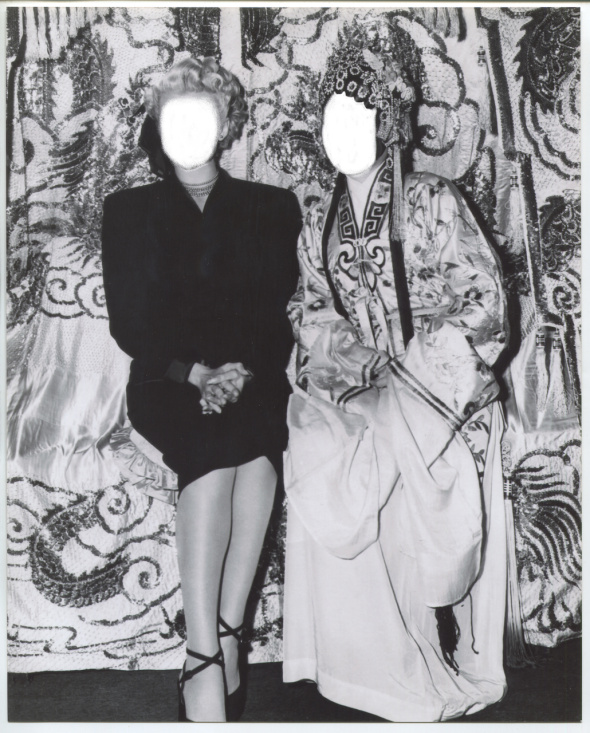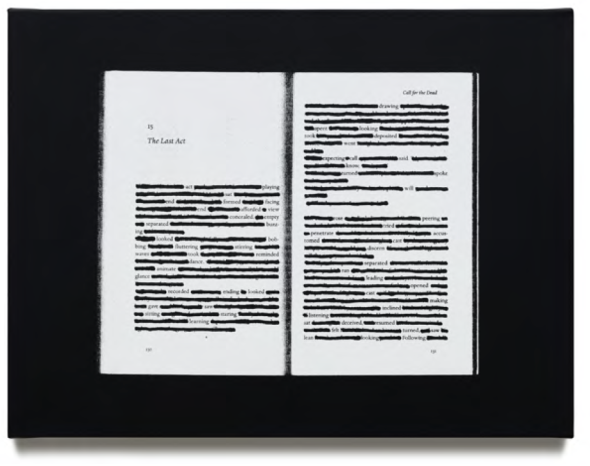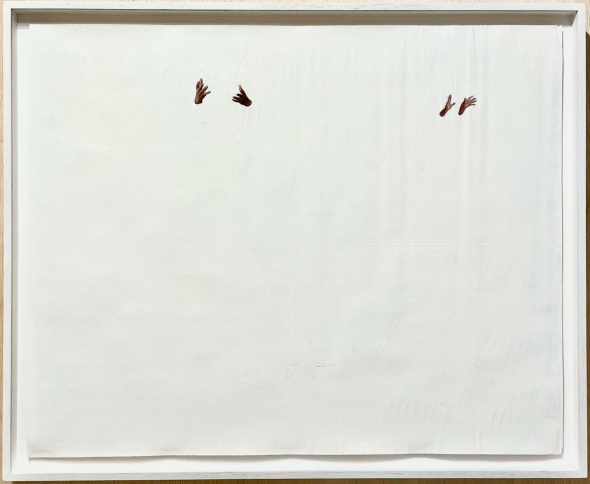Selected works from the Monsoon Southeast Asia collection reflect the multiple ways that artists from the region are using the visual language of erasure and obfuscation to portray notions of destruction, censorship, memory, and anonymity. Visible erasures of figures and texts might be read as an act of violence and destruction or an implied negation of truth and reality. It might suggest an interplay of power and authority as well as an imposition of order. Obscured facial features might reflect notions of identity and individuality or suggest a space for reimagination and transcendence.
Main image: Boy Blue, (2012). © Yasmin Sison-Ching.
Erasure and Obfuscation in Southeast Asian contemporary art

In an interview about what is probably his most well-known work, Le fils de l’homme (Son of Man), 1964, the Belgian surrealist painter Rene Magritte noted that this self portrait, with the artist's face partially obscured by a floating green apple, engages with the conflict "between the visible that is hidden and the visible that is present." In much the same way, visual artists from Southeast Asia engage in the tension between presence and absence in order to reflect various contemporary concerns.
Selected works from the Monsoon Southeast Asia collection reflect the multiple ways that artists from the region are using the visual language of erasure and obfuscation to portray notions of destruction, censorship, memory, and anonymity. Visible erasures of figures and texts might be read as an act of violence and destruction or an implied negation of truth and reality. It might suggest a power play or a means to impose order. Obscured facial features might reflect notions of identity and anonymity or suggest a space for reimagination and transcendence.
Poklong Anading's interest in identity in contemporary society finds expression in two photographic series that employ the obfuscation of individual identities. Although his Anonymity series explores notions of identity and urbanisation and his -------- series engages with the environmental impact of single-use plastics, both utilise similar visual expressions of obfuscation and hidden identity.
Yasmin Sison-Ching makes use of erased figures to convey ideas about the act of remembrance and the fallibility of memory. The erasures decontextualise the paintings from their original photographic sources and embody through vivid gestural strokes the ephemeral nature of memory or the pain associated with forgetting as suggested in the "erasure" works, Boy Blue, 2012 and A Tenuous Sound, (2010).
On the other hand, Ming Wong uses erasure as a critique of early 20th century films that cast white actors in Asian roles, a tradition known as "yellow face." In The Lady from S, 2022, Wong meticulously erases the features of the white actor by hand, thereby redressing the exaggerated caricaturisation and ethnic stereotyping of Asians in such films by creating a portal by which more truthful representations of Asian culture and ethnicity might be reimagined for our time.
Selected works from the Monsoon Southeast Asia collection reflect the multiple ways that artists from the region are using the visual language of erasure and obfuscation to portray notions of destruction, censorship, memory, and anonymity.

Other artists make use of erasure and obfuscation to make processes and power structures more visible. Annie Cabigting's work, Destroyed Painting...After Bacon, (2007), for example is a reflection on the thin line between creation and destruction, as seen through the lens of Western art history. Focusing on the discarded canvases that did not meet the exacting standards of the artist Francis Bacon, Cabigting's use of negative space to obfuscate the subject of the portrait conveys both the implied violence and the surreal beauty of Bacon's failed picture.
The erasure of text visualises the act of censorship, a power often associated with governments, secrecy, and espionage. In Call for the Dead #73, Heman Chong presents pages of John Le Carre's spy novel that have been subjected to heavy redaction at the hand of the artist as an exploration of the furtive nature of foreign affairs and geopolitics.
Similarly, Lai Yu Tong uses white paint to create order and clarity within the visual cacophony of images and text of a newspaper page. In Newspaper Painting No. 111, 2021 painting takes on a reductive purpose to bring focus on two pairs of hands. The work is a recognition of the central role that hands play in the processes of destruction and creation.
This small sample of works in the collection creates an interesting dialogue between artists from the region, presenting various strategies where the tension between the visible and the hidden offers insight into contemporary issues and concerns.


© Heman Chong / STPI. Photo courtesy of the Artist and STPI.


Subscribe and Stay Updated with us!
If you like to stay updated on the latest news about the collection, please enter your emai.
